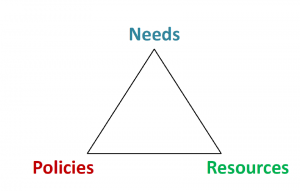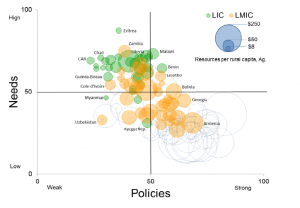Progress toward food and nutrition security needs to be sharply accelerated to achieve the SDGs. The G20 should systematically track progress reports on the state of food and nutrition security (FNS) made by international agencies and, based on this, they should scale investment opportunities and target their interventions to maximize impact on people and transformation of rural areas. Such tracking should include G20 countries themselves and countries they support with development assistance. Currently, few countries target investments, technical assistance, capacity building and policy support in a data-driven way. The G20 could develop such a methodology and identify priority countries and intervention points where additional investments and international assistance could have a transformative impact.
Challenge
The G20 has taken up the challenge of improving global food security, producing a Food Security and Nutrition Framework paper in 2014 under the Australian presidency, adopting a Food Security Action Plan in Antalya in 2015, and endorsing a proposal on good practices on family farming and smallholder agriculture in Hangzhou in 2016. Taken together, these present an understanding of the principal challenges. First, agricultural productivity increases must be scaled up and spread out. With roughly 800 million undernourished people and 150 million stunted children, as well as pressures from additional population and income growth, global food supply must rise by at least 50 percent by 2050, a distinct challenge in an environment where climate change, degraded lands and water scarcity pose threats to productivity in many areas. Second, the 2 to 2.5 billion people reliant on 500 million family farms must secure sufficient income from sustainable farming and rural off farm employment to have access to sufficient, safe and nutritious food. Third, vulnerability to temporary loss of food security must be dealt with.
There has been progress in improving global food and nutrition security but the pace is too slow. At least a doubling of the current average rate of progress is needed. In the next 15 years, progress in reducing undernourishment will need to rise to 55 million people per year. Within this average, some countries, and some smallholder farmers within these countries, are falling behind. In some cases, the potential pace of progress is linked to the country’s endowment in natural resources that considerably influences the potential to achieve food and nutrition security. In Africa, this will mean ending hunger for the same number of people in 15 years as happened in Asia over the past 25 years. Most distressing, in 2015 and 2016 the number of hungry people in sub-Saharan Africa has climbed by roughly four million annually, cumulatively growing from some 175 million in 1990 to 220 million today. Today, in March 2017, some parts of East Africa as well as Yemen and Nigeria report famine conditions and require urgent attention by G20. Furthermore, hidden hunger and micro-nutrition insecurity deserve more attention. If the world is to end all types of hunger by 2030, it will need to make much, much faster progress.
G20 countries are major providers of development assistance for food security and nutrition, as well as major shareholders of multilateral development banks that channel aid and non-concessional finance for investments in rural development. In a global context of stagnating budgetary resources, it is even more important to allocate resources effectively. Targeting assistance, by country, should be a central theme of the G20.
Proposal
Food security will largely depend on individual government efforts in each country, but the international community can support these national efforts in four ways.
- G20 members can collectively help integrate global food markets and make them function more efficiently. There is some good news in this regard but more can be done and the gains must be sustained. Both developing and developed countries have reduced biases and distortions in international agricultural trade. Countries have agreed to eliminate agricultural export subsidies and credits, thereby ending long-standing market imperfections.1 Nevertheless, greater consistency in policies on trade, aid, development, biofuels and climate could contribute to better FNS outcomes.
Developing countries have worked to integrate their domestic food markets, building hard and soft infrastructure to enhance market connectivity of smallholders. Regional integration of food markets has progressed in South East Asia and parts of Africa. Access to input markets for improved seeds, fertilizer, machinery and finance needs strengthening. More efficient risk-sharing could be transformational. Government-level risk instruments like the African Risk Capacity mechanism can also help to mitigate the effects of widespread disasters. - The G20 can still do more to invest in agricultural research, extension, and data systems, especially in and for developing countries themselves. The G20 has already promoted international collaboration through meetings of agriculture ministers and agricultural chief scientists. It is also promoting the sharing and application of data through a number of portals, including the global open data for agriculture and nutrition (GODAN), the coherence in information for agricultural research for development (CIARD), the global agricultural monitoring initiative (GEOGLAM), and the agricultural market information system (AMIS).
In the future, more emphasis should be placed on research for neglected tropical crops, for sustainable intensification, for helping to make existing crops more resilient to climate change (heat, pests and diseases, droughts and floods), and for adapting recommendations to suit local conditions and improve uptake.The G20 should pay particular attention to building evidence on smallholder, women and youth productivity and uptake of new approaches that can raise productivity and improve nutrition, including simple sustainable farming technology. - The G20 should take the lead in reshaping the global food system to sustainably deliver on food security, nutrition, climate and other development goals, recognizing the implications of the growing demand for animal sourced food. It should assess whether the relevant international organizations and initiatives where members have a large majority stake are optimizing their contributions. An increasing number of platforms and partnerships have emerged recently to tackle issues of markets, resources and science, but they risk overlap and dilution of efforts one one hand, and “orphan” issues of unfilled need on the other hand. Through ministerial meetings, G20 members can assess the functioning of the global food security system as a whole, to provide context for individual organization replenishments, mandate changes, and reform of the food governance system.1
- The G20 should make the targeting of investments in agriculture, livestock, fisheries and forests, by country, a central theme, as further discussed below, and identify a core group of countries where international assistance for food security is likely to have greatest impact. The complex emergencies drifting towards famines in East Africa in 2017 highlight that food and nutrition security cannot be tackled properly without consideration of security and diplomacy. This is a matter for G20 leadership, and not just for technical agencies. Identifying priority countries requires a data base that can be used for G20 policy coordination on and prioritization of FNS assistance along with coherent policies in non-agricultural areas that affect FNS.2
Unfortunately, after an initial expansion in 2009, aid for food and nutrition security (FNS) has stagnated of late.3 Significant foreign resources for rural development are also being made available in the form of non-concessional lending and commercial foreign direct investments. South-south cooperation is on the rise too, and has significant potential. Innovative ways of bundling finance to achieve greater leverage of official aid could help.
Financial resources could be deployed more effectively. For example, research suggests that increasing aid going towards nutrition could have very high returns. Targeting infant and child undernutrition and biofortification can have important impacts on health and future labor productivity. Food aid volatility is also a major problem, given a historical pattern of food aid following food price spikes and falls. Reaching the global goals will require FNS resources to be committed as long-term and predictable sources of investment.
The main challenge for effectiveness, however, is to determine, on the basis of evidence, the countries and intervention points where international assistance is likely to have the greatest impact on food and nutrition security and rural transformation.
Country targeting should be based on, and address, three factors: country needs, policies, and available financial resources. In the best case, the fastest SDG results will be achieved by supporting countries with high needs, strong domestic policies, and very limited resources. In the worst case, little will be gained by supporting countries with low needs, weak policies, and extensive resources.
Currently, only a small share of G20 investments in food security and nutrition is targeted to priority countries. The G20 has not articulated any shared quantitative goals for ending hunger, and thus is not holding itself accountable for the effectiveness of the investments made by individual members. There is no agreement across G20 countries on a targeting framework or principles to guide targeting.
Proposed Approach
Figure 1 shows a simplified framework with three dimensions: needs, policies and resources. If metrics can be attached to each dimension, then the impact of international investment can be considered by evaluating trade-offs. For example, some countries with high needs may not have adequate domestic policies in place to support a dynamic agricultural sector. In such cases, projects developed and implemented with international assistance will have to balance the short-term gains from helping a given number of project beneficiaries against the reduced likelihood of systemic rural transformation given an unsupportive policy environment. In other instances, countries with good policies may already have adequate resources for investment themselves, so the marginal contribution of international assistance might be correspondingly low.
The value-added of quantifying the targeting framework is to force a discussion of where resources might have the most impact, and to identify what kind of additional policy changes might be needed to ensure that food security investments have a transformative impact. A targeting framework could help G20 countries do just that and at the same time, could provide an evidence base for other countries to understand their own responsibilities for structural reform to make international assistance more effective.
Figure 1 – A Simple Targeting Framework: Needs, Policies, and Resources

- Needs. The SDG for ending hunger includes four underlying targets that are well suited for country-level assessment. In simplified terms, these are: (i) end undernourishment, (ii) end malnutrition, (iii) boost smallholder agricultural productivity and incomes, and (iv) ensure resilient agricultural systems. By collating and synthesizing relevant indicators for each target, the nature and extent of each country’s needs can be assessed. The higher the needs, the stronger the case for targeting the country.
- Policies. On average, countries with higher levels of income per capita tend to have better domestic FNS policies (such as favorable rural investment climates, land rights for women farmers, and agricultural trade policies) and less hunger. However, at any particular level of income, countries with better FNS policies also tend to have lower levels of hunger. Assessing, first, the quality of local economic policies and, second, the extent to which political leaders prioritize FNS is an important component of targeting. The better the policies and proven national commitment, the stronger the case for targeting the country.
- Resources. Countries that invest more in FNS tend to have lower hunger needs. Again, this is true after controlling for income levels. Many countries in sub-Saharan Africa have made commitments to raise agricultural spending in the Malabo Declaration but few have met their commitments. The more resources available in a country—be they from domestic budgets, international donors, or foreign investment or philanthropy, the weaker the case for targeting the country to receive additional resources.
Benchmarking
Benchmarking each country’s needs, policies, and resources against each other allows an evidence-based approach to targeting. As an example, Figure 2 maps developing countries based on their current overall FNS needs (on the vertical scale), policies (on the horizontal scale), and resources (the size of the bubble). Green bubbles indicate low-income countries and orange bubbles indicate lower-middle-income countries.
Figure 2: Benchmarking Rural Hunger Needs, Policies and Resources

Note: Low Income Countries (LIC) and Lower Middle Income Countries (LMIC) follow World Bank classifications.
Source: Ending Rural Hunger, 2015, The Brookings Institution.
Figure 2 highlights several points. Most countries in the bottom right hand quadrant (low needs and strong policies) also have high investments in FNS. The combination of high investments and strong policies creates good FNS outcomes.
The figure also highlights that many countries have high needs and relatively strong policies, but are still unable to attract enough resources to make large investments. This includes countries like Malawi, Benin, Lesotho and Bolivia.
Many other countries also have high needs and very low available resources, but have a weaker domestic policy environment. Development partners need to determine the magnitude of any transformational change that can be achieved by investing in these countries.
Identifying country needs, policies and resources is a crucial first step in identifying country priorities. The example above suggests a methodology drawn from one academic study, but the point here is simply to argue for an evidence-based approach to targeting food security, not to advocate for some countries and against others, or for one approach versus another. It will be important that targeted countries identify outcomes and improve effectiveness through a dynamic learning process where data are analyzed over each stage of the investment cycle. The G20 should task its agricultural and development ministers and chief scientists to develop a framework and list of highest priority countries.
The T20 Task Force on “Ending hunger and sustainable agriculture” is co-chaired by Joachim von Braun (ZEF, Bonn University, Germany), Ashok Gulati (ICRIER, New Delhi, India), and Homi Kharas (Brookings, Washington DC, USA). These authors are solely responsible for the content and their views do not necessarily represent the views or recommendations of their related institutions.
Members of the task force are: Li Xiaoyun (China Agricultural University’s College of Humanities and Development, China International Development Research Network (CIDRN), China), Jikun Huang (Center for Chinese Agricultural Policy of Chinese Academy of Sciences, China), Sachin Chaturvedi (Research and Information System for Developing Countries (RIS), India), Martín Piñeiro (Argentina Council for Foreign relations (CARI), Argentina), Catherine Bertini (Chicago Council on Global Affairs, USA), Rebecca Nelson (Cornell University, USA), Shenggen Fan and Rajul Pandya-Lorch (International Food Policy Research Institute (IFPRI), USA), Jean Lebel, Dominique Charron (International Development Research Centre (IDRC), Canada), Achim Dobermann (Rothamstead Research, UK), Nick Vink (University of Stellenbosch, South Africa), Regina Birner (University of Hohenheim, Germany), Michael Brüntrup, Ines Dombrowsky (German Development Institute (DIE), Germany), Ruth Delzeit (Kiel Institute for the World Economy (IfW), Germany), Heike Baumüller, Nicolas Gerber, Alisher Mirzabaev, Mekbib Haile (Center for Development Research (ZEF), University of Bonn, Germany), Ken Giller (Wageningen University, The Netherlands), Jörg Hacker (German National Academy of Sciences Leopoldina, Germany), Hermann Lotze-Campen (Potsdam Institute for Climate Impact Research (PIK), Germany), Michael Obersteiner (International Institute for Applied Systems Analysis (IIASA), Austria), Matin Qaim (University of Göttingen, Germany)
Endnotes
1See more on these governance aspects in G20 Insights, T20 Policy Brief on “Key Policy Actions for Sustainable Land and Water Use serving people. January 16, 2017.
2For examples of prioritization, see IFPRI’s Best Bets study, Copenhagen Consensus’ biggest bang for every buck, Brookings’ Ending Rural Hunger database and report, and Center for Development Research (ZEF) “Tapping the Potentials of Innovation for African Food Security and Sustainable Agricultural Growth an Africa-wide Perspective”
3See CRS debt Statistics database of the OECD/DAC. One exception is the case of Germany where the “one world, no hunger” initiative has led to an increase in FNS aid.
References
- State of Food Insecurity in the World, 2015, FAO, IFAD, World Food Programme
http://www.fao.org/3/a-i4646e.pdf - Ending Rural Hunger, H. Kharas, J. McArthur et al., October 2015
https://assets.contentful.com/5faekfvmlu40/3QhEcuQRO8OACqIWKMi6CK/cd474f0e01a1170a07581346597666d9/ERH_Full_Report.pdf - The WTO’s decision to end agricultural export subsidies is good news for farmers and consumers, H. Strubenhoff, Feb 2016
https://www.brookings.edu/blog/future-development/2016/02/08/the-wtos-decision-to-end-agricultural-export-subsidies-is-good-news-for-farmers-and-consumers/ - Targeting Efforts to End Hunger by 2030, H. Kharas and J. McArthur, April 2016
https://www.thechicagocouncil.org/blog/global-food-thought/guest-commentary-targeting-efforts-end-hunger-2030 - Best bets for Reducing Poverty and Hunger, IFPRI, 2008
http://www.ifpri.org/news-release/best-bets-reducing-poverty-and-hunger - Post-2015 Consensus, Copenhagen Consensus, 2015
http://www.copenhagenconsensus.com/post-2015-consensus/news/smart-development-goals-get-biggest-bang-every-buck-paint-bulls-eye-19 - Tapping the Potentials of Innovation for African Food Security and Sustainable Agricultural Growth an Africa-wide Perspective, Center for Development Research (ZEF), 2015
http://research4agrinnovation.org/wp-content/uploads/2015/12/Africa_study-engl.pdf








